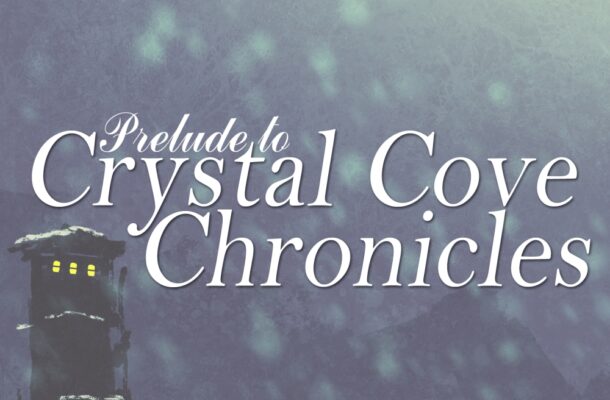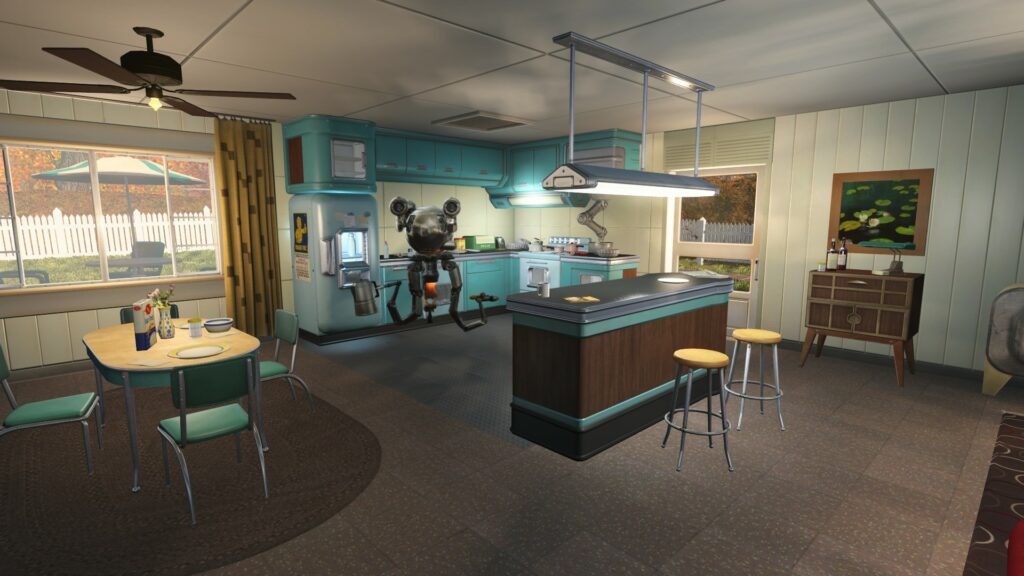
After spending 23 parts talking about all the ways in which Fallout 3 failed and could have been so much better, I figure we need a bit of a palate cleanser. So let’s talk about how bad Fallout 4 is instead! This will be a 4 part mini-series focusing mostly on the game’s opening, and why it doesn’t work. I originally mentioned this in a brief side note during the main Certified Fallout-Free series, so this is really just digging into that complaint a bit more thoroughly. With that said…
Fallout 4 has a problem. Actually, that’s a lie, Fallout 4 has many problems, but one of the biggest for me is the initial narrative hook: Nate or Nora’s death, and the search for Shaun. Spoilers, by the way.
Fallout 4’s opening segment is handled so incredibly poorly that I’m honestly not sure how any writer could look at it and think ‘yes, this is a good story’. One of the biggest problems with the game’s story is the use of assumed empathy. This is where the writer makes the assumption that people will care about something just because of x, y, or z thing. In this case, your character has a kid who’s been kidnapped, so you care about it, right? Of course you do!
Or do you? No, not really, because I don’t know these people and I don’t care about them yet, so why should I give the remotest of craps that their kid was taken and one of them was murdered?
Sure, the in-game character of Nate or Nora knows their spouse, and has spent maybe a year or so looking after their kid. So they have a stake in the world. But the player does not know these people. You get a total of around 10 minutes with them before Shaun is kidnapped and the spouse is killed. That’s not enough time to learn what they had for breakfast, never mind the kind of people they are, or why we should care about them.
Mass Effect had a similar problem in its third game, centring a lot of the main conflict on the invasion of Earth. But again, we don’t know anyone on Earth, except perhaps Anderson. It’s just a random planet of 11 billion people, no different to the Turian or Asari homeworlds. The writers assumed the player would care simply because it’s Earth, and we happen to live on that planet in real life.
Remember the marketing campaign? Take Back Earth? They completely changed the focus of the whole trilogy’s conflict away from the Reapers themselves, and towards a planet we’ve never even been to in the previous games. This is not something you should be doing in the third part of a trilogy. Though it’s also true that you shouldn’t be using the second part of your trilogy for a largely pointless side mission that has no real bearing on the main story either. Yeah, Mass Effect has lots of problems as well.
Anyway, assuming people will care about something because of ‘x’ is precisely backwards. You, the writer, need to make the audience care, by showing them interesting characters, having those characters get into difficulties, and then having them resolve those difficulties in some form or fashion, whether in a positive or negative way. You need to give the audience a reason to care.
(Side note: assuming that people will care just because it happens to be humans or Earth that are in trouble is also silly. As we’ve seen recently, there are people who will unironically side with the bugs in Starship Troopers or Helldivers over their own species. Never assume.)
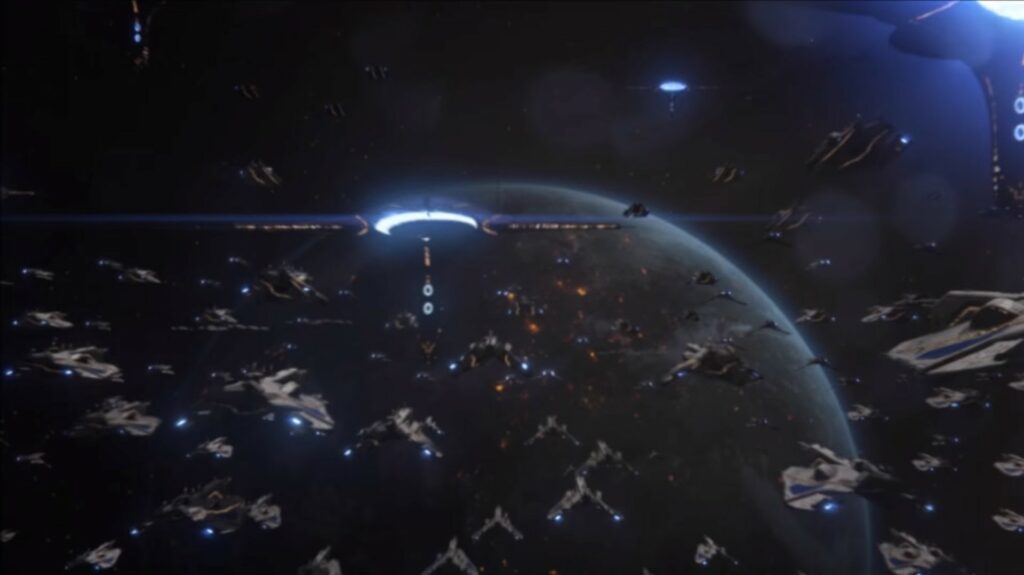
Here’s an example of how to do it the right way: The Hitchhiker’s Guide to the Galaxy. In this book (the first of a trilogy in five parts) we spend the opening pages getting to know Arthur Dent, the unwilling protagonist of the series. We learn a little about him, his personal world—small though it is—as well as his likes and dislikes, his worries and anxieties, and his friendship with the stylish and flamboyant Ford Prefect.
During these opening scenes we are given enough information to care about the character and his plight, and to feel something for him when not only is his house destroyed, but Earth, too. Arthur struggles to come to terms with what has happened because it’s just too big. The very idea of Earth being gone is hard to wrap his head around. So instead he takes it down to a personal level, thinking of how certain things such as McDonalds are no longer around.
See the similarities between this and assumed empathy? The idea that Arthur can’t even process Earth’s destruction except on a micro level is effectively the same principal as assuming people will care about Earth being in danger or destroyed, without showing them why they should care. Like Arthur struggles to comprehend Earth’s destruction, the reader would struggle to care about it if they hadn’t first been introduced to characters to care about.
I use Hitchhiker’s Guide as a good example here precisely because Douglas Adams understood how to write the opening to a story. He knew that the audience would need a thorough grounding in the world, with characters to care about, before blowing up a planet near the beginning of the first book.

Now, while I think the whole laughably broken story in Fallout 4 should be thrown out and rewritten by someone who is actually competent (we’ll get to Emil Pagliarulo later), that’s not what I’m going to talk about here.
Instead, I’m going to look at the issue of assumed empathy and see how we might go about fixing it with regards to Nate and Nora specifically, reworking the story to accommodate rather more consistency and logic, while simultaneously not changing the game so drastically that you’d effectively have to rework everything. So essentially… what I already did with Fallout 3, just on a smaller scale.
First things first, while I get what they were going for in the whole opening Pre-War sequence, it just doesn’t work. For starters, it’s a ridiculously rosy view of the world that doesn’t take into account incredibly serious societal problems that went way beyond mere rioting and civil unrest. The New Plague was sweeping the nation at this point in history, and people were actively discouraged from associating with each other or even leaving the house…
Hang on a minute, this all sounds very familiar, doesn’t it? New Plague… tensions with China… massively corrupt US government… oh hell, are we seriously living in the Fallout timeline, but without any of the cool stuff like fusion cars and power armour? Dammit, real world, why do you suck so much?
Anyway…
The very idea that this idyllic little village where Nate and Nora live could even exist in such a strained world is silly at best, and downright idiotic at worst. Bethesda’s writers either didn’t bother doing their research, or simply didn’t care. More likely both.
There are ways this section could be fixed, if you felt so inclined. For example, simply take this idyllic village that shouldn’t even exist and make it propaganda. The unrealistically idyllic nature of the opening segment was just a front, the keeping up of appearances during an insanely costly war, and the government attempting to put a rosy veneer on a major problem.
Personally, I’d probably have gone with something similar to Fallout 3’s opening, if we really must have the player character be yet another Vault Dweller. Opening narration happens, introducing the idea that we were part of, let’s say, an experiment in cryogenic freezing where the whole point was to freeze families for the purpose of repopulation in the future, as well as research for long-distance space travel.
Maybe the plan was for the Vault to open after 50-75 years, enough time for most of the radiation to have cleared up (though the Vault would have supplies of rad suits and the like anyway), and the idea was for these people to help reclaim the world.
The cryo freezing itself actually fits neatly into the ideas the original two games presented, so I’ll give Bethesda credit there; this Vault actually makes sense, unlike some of Fallout 3’s. Of course, this isn’t a social experiment, but then technically neither was Vault 12 in Fallout 1, so I can let that slide. They both tie into the idea of going to space.
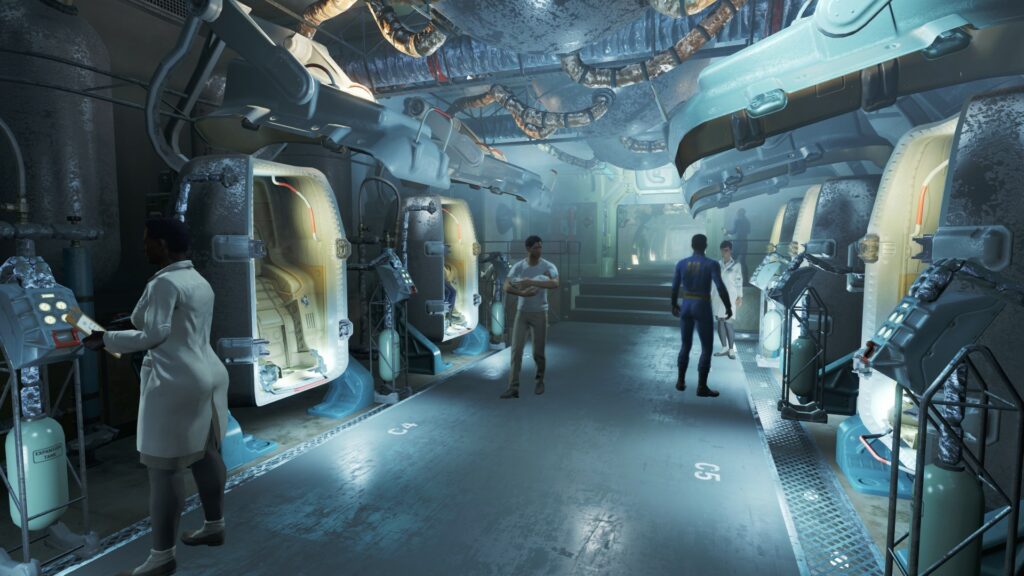
Either way, our first scenes from the player’s point of view could then be getting prepared to enter the Vault for the big sleep, similar to how it happens now. Except we wouldn’t be thawed out early, and our spouse wouldn’t be killed by a random bald dude dressed in a suspicious amount of leather.
Upon being thawed, we’re now in the ruined post-apoc world and this is where the rest of the tutorial happens, and we finish off the opening act of the game. First up, we’d have a quick examination by the Vault doctors to make sure there are no major side effects of the unfreezing process, which is where SPECIAL allocation would happen, plus hinting at a big plot point for later.
After a mere five to ten minutes of game time, we’re into the main meat of things. No messing about, no ret-conning of lore, and no assumed empathy, since both player character and spouse are alive, along with Shaun (I’ll be working within the constraints of the game world as it exists now, so yes, Shaun is around).
The Vault would be alive with people milling about and talking, providing the player with ample opportunities for speech, barter, and other non-combat dialogue checks. There’d be Vault employees reassuring everyone that things are going to be fine, similar to the vanilla opening when you enter Vault 111. But through dialogue and potentially even locked areas the player can sneak into and explore (introducing hacking and lockpicking), you’ll get the idea pretty quickly that something isn’t quite above board here.
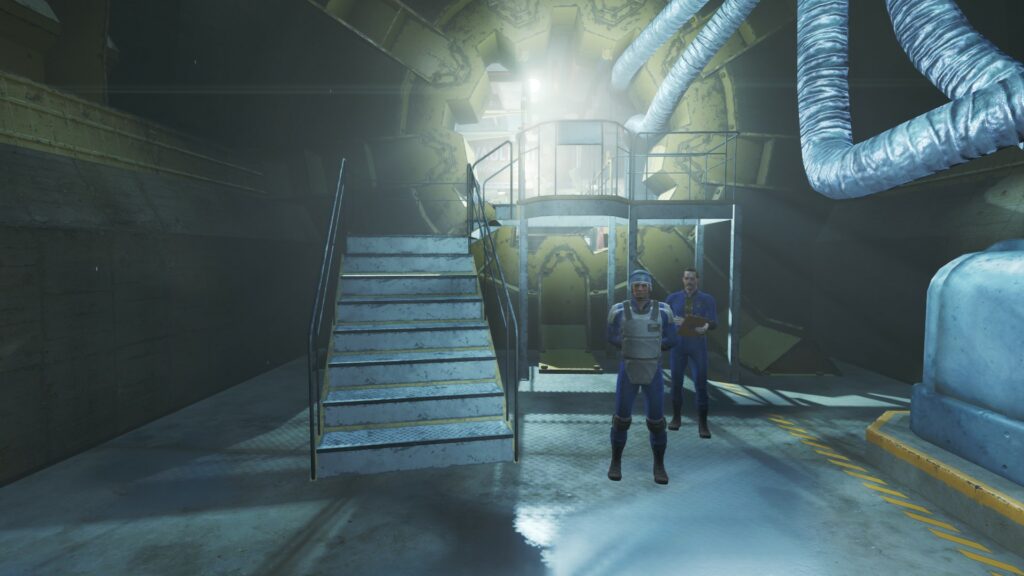
Similar to how you leave the Vault and head to Sanctuary Hills, your first buildable settlement of the game, you’ll leave the Vault with all the other residents, heading to the surface. There’ll be plenty of dialogue and flavour to be had here, especially from the horrified vault dwellers at seeing this shattered world.
There’ll be supply lines from the Vault leading to Sanctuary Hills itself, with equipment in the process of being moved. There’d already be guards and patrols in the town, sent over by the Vault staff before unfreezing everyone, so it’ll be a pretty safe location for now. Surrounding the region will be animals and a few monsters, as it is in vanilla, and a couple of early quests will involve acclimating the player to the world by having them hunt these for meat / pelts / increased safety / whatever.
At this point, the tutorial basically ends. The player has been shown most of the basics, given a grounding in the world, and an initial quest to head to this place called Diamond City in order to establish supply lines with civilisation. Whoever you’re playing gets this task, the spouse then sets up home in Sanctuary Hills for now.
Next time, I’ll go a bit more into detail about potential ways to proceed from this basic premise.
If you enjoy my work, consider buying me a coffee, or jump onto my newsletter to receive updates, free chapters, stories, and other goodies.


